Integrated Module Antenna for Automotive UWB Application
Abstract
:1. Introduction
2. Proposed Antenna Design
2.1. Considerations for Antenna Design
2.2. Design of the Prototype Antenna
2.3. Pattern Improvements with Modified Ground Stubs and Parasitic Radiators
2.4. Fabrication and Measurement
2.5. Vehicle Model Simulation
3. Conclusions
Author Contributions
Funding
Institutional Review Board Statement
Informed Consent Statement
Data Availability Statement
Conflicts of Interest
References
- Liu, X.; Tan, W.; Shen, Z.; Jin, C. Integrated Frequency-Selective Surface and Antenna Printed on a Transparent Substrate. IEEE Antennas Wirel. Propag. Lett. 2020, 19, 2062–2066. [Google Scholar] [CrossRef]
- Zhong, Z.-P.; Zhang, X.; Liang, J.-J.; Han, C.-Z.; Fan, M.-L.; Huang, G.-L.; Xu, W.; Yuan, T. A Compact Dual-Band Circularly Polarized Antenna with Wide Axial-Ratio Beamwidth for Vehicle GPS Satellite Navigation Application. IEEE Trans. Veh. Technol. 2019, 68, 8683–8692. [Google Scholar] [CrossRef]
- Bryant, B.; Won, H.; Hong, Y.-K.; Lee, W.; Choi, M. Design of Triple-Band (DSRC, 5G, 6G) Antenna for Autonomous Vehicle Telematics. Electronics 2022, 11, 2523. [Google Scholar] [CrossRef]
- Trujillo-Flores, J.I.; Torrealba-Meléndez, R.; Muñoz-Pacheco, J.M.; Vásquez-Agustín, M.A.; Tamariz-Flores, E.I.; Colín-Beltrán, E.; López-López, M. CPW-Fed Transparent Antenna for Vehicle Communications. Appl. Sci. 2020, 10, 6001. [Google Scholar] [CrossRef]
- Cheng, Y.; Lu, J.; Wang, C. Design of a multiple band vehicle-mounted antenna. Int. J. Antennas Propag. 2019, 2019, 11. [Google Scholar] [CrossRef]
- Jang, D.; Kong, N.K.; Choo, H. Design of an on-glass 5G monopole antenna for a vehicle window glass. IEEE Access 2021, 9, 152749–152755. [Google Scholar] [CrossRef]
- Ahmad, W.A.; Kucharski, M.; Ergintav, A.; Ng, H.J.; Kissinger, D.A. Planar Differential Wide Fan-Beam Antenna Array Architecture: Modular high-gain array for 79-GHz multiple-input, multiple-output radar applications. IEEE Antennas Propag. Mag. 2021, 63, 21–23. [Google Scholar] [CrossRef]
- Lee, H.; Song, H.J.; Eshaq, N. Compact UWB Cellular Antenna Integrated into Vehicle Spoiler. In Proceedings of the IEEE International Symposium on Antennas and Propagation and USNC-URSI Radio Science Meeting (AP-S/URSI), Denver, CO, USA, 10–15 July 2022. [Google Scholar]
- Schires, E.; Georgiou, P.; Lande, T.S. Vital Sign Monitoring through the Back using an UWB Impulse Radar with Body Coupled Antennas. IEEE Trans. Biomed. Circuits Syst. 2018, 12, 292–302. [Google Scholar] [CrossRef] [PubMed]
- Lim, S.; Jung, J.; Kim, S.C.; Lee, S. Deep Neural Network-Based In-Vehicle People Localization Using Ultra-Wideband Radar. IEEE Access 2020, 8, 96606–96612. [Google Scholar] [CrossRef]
- Potti, D.; Tusharika, Y.; Alsath, M.G.N.; Kirubaveni, S.; Kanagasabai, M.; Sankararajan, R.; Narendhiran, S.; Bhargav, P.B. A novel optically transparent UWB antenna for automotive MIMO communications. IEEE Trans. Antennas Propag. 2021, 69, 3821–3828. [Google Scholar] [CrossRef]
- Mohanty, A.; Wu, A.; Bhamidipati, S.; Gao, G. Precise relative positioning via tight-coupling of GPS carrier phase and multiple UWBs. IEEE Robot. Automat. Lett. 2022, 7, 5757–5762. [Google Scholar] [CrossRef]
- Kwon, O.Y.; Song, R.; Kim, B.S. A Fully Integrated Shark-Fin Antenna for MIMO-LTE, GPS, WLAN, and WAVE Applications. IEEE Antennas Wirel. Propag. Lett. 2018, 17, 600–603. [Google Scholar] [CrossRef]
- Wu, Q.; Zhou, Y.; Guo, S. An l-sleeve l-monopole antenna fitting a shark-fin module for vehicular LTE WLAN and car-to-car communications. IEEE Trans. Veh. Technol. 2018, 67, 7170–7180. [Google Scholar] [CrossRef]
- Khalifa, M.O.; Yacoub, A.M.; Aloi, D.N. A Multiwideband Compact Antenna Design for Vehicular Sub-6 GHz 5G Wireless Systems. IEEE Trans. Antennas Propag. 2021, 69, 8136–8142. [Google Scholar] [CrossRef]
- Liu, Y.; Ai, Z.; Liu, G.; Jia, Y. An Integrated Shark-Fin Antenna for MIMO-LTE, FM, and GPS Applications. IEEE Antennas Wirel. Propag. Lett. 2019, 18, 1666–1670. [Google Scholar] [CrossRef]
- Wang, Z.; Liu, S.; Dong, Y. Compact Wideband Pattern Reconfigurable Antennas Inspired by End-Fire Structure for 5G Vehicular Communication. IEEE Trans. Veh. Technol. 2022, 71, 4655–4664. [Google Scholar] [CrossRef]
- Alsath, M.G.N.; Arun, H.; Selvam, Y.P.; Kanagasabai, M.; Kingsly, S.; Subbaraj, S.; Sivasamy, R.; Palaniswamy, S.K.; Natarajan, R. An integrated tri-band/UWB polarization diversity antenna for vehicular networks. IEEE Trans. Veh. Technol. 2018, 67, 5613–5620. [Google Scholar] [CrossRef]
- CST. Dassault Systemes. Available online: http://www.cst.com (accessed on 19 October 2022).
- Alsath, M.G.N.; Kanagasabai, M. Compact UWB monopole antenna for automotive communications. IEEE Trans. Ant. Prop. 2015, 63, 4204–4208. [Google Scholar] [CrossRef]
- Hum3D. Available online: http://www.hum3d.com (accessed on 19 October 2022).

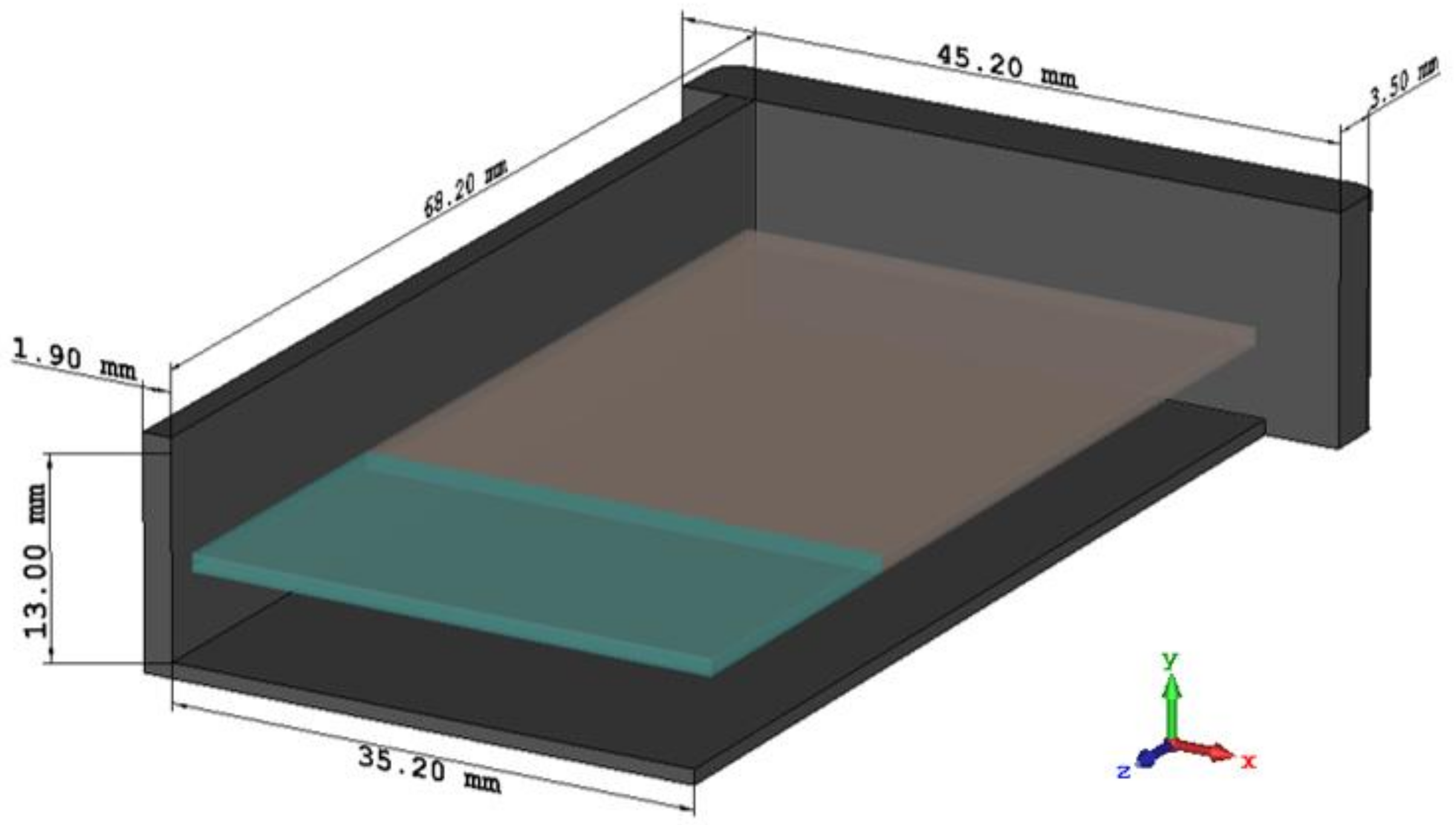
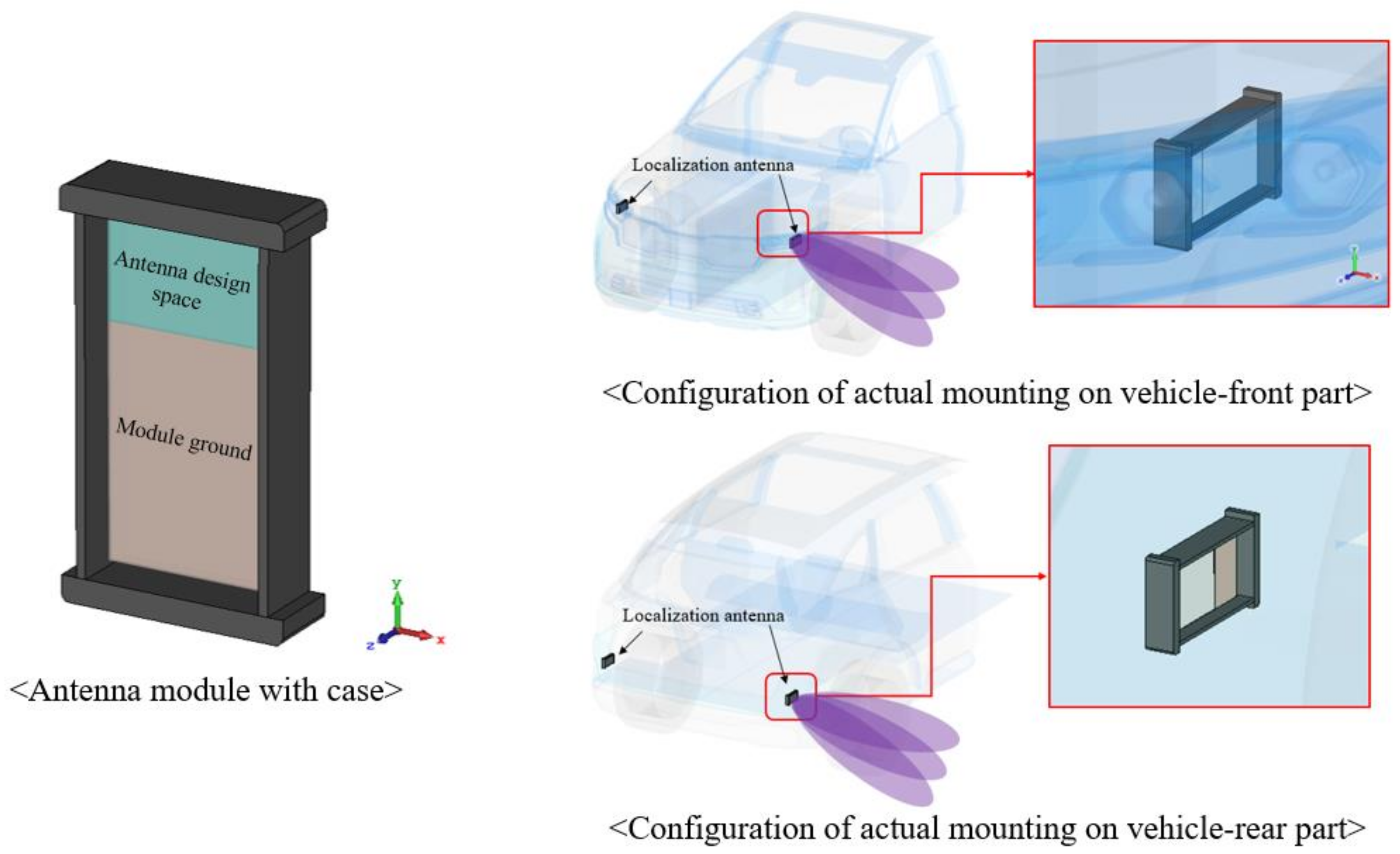
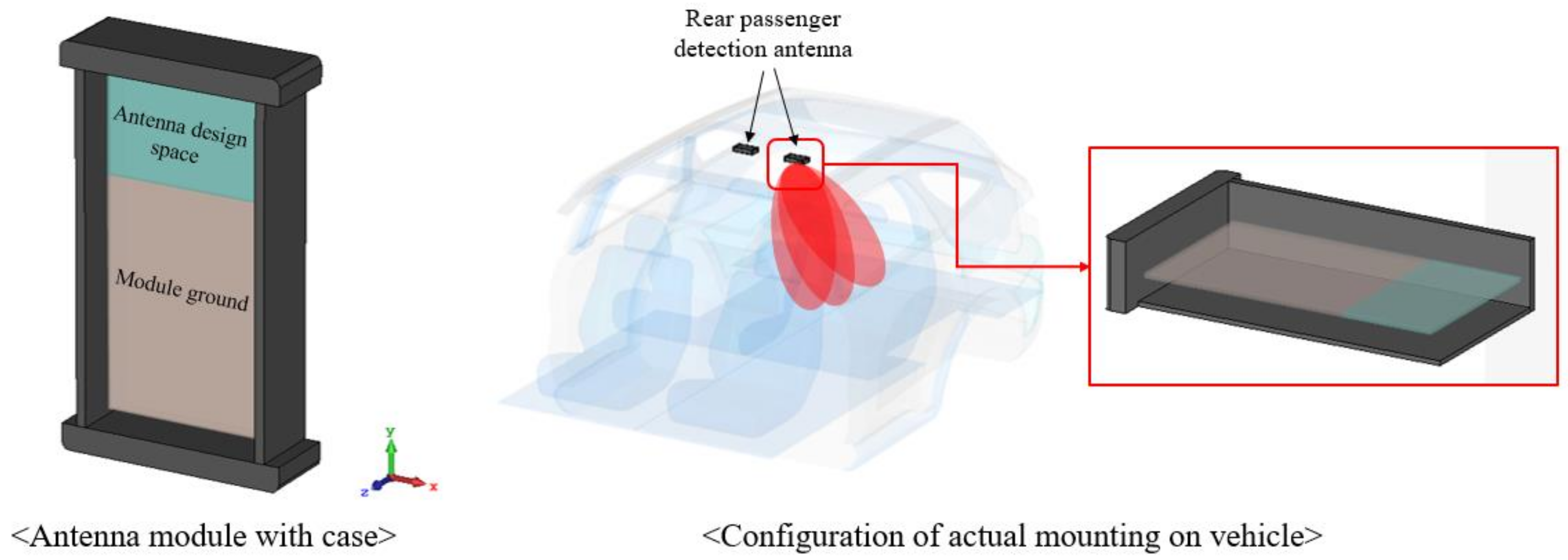
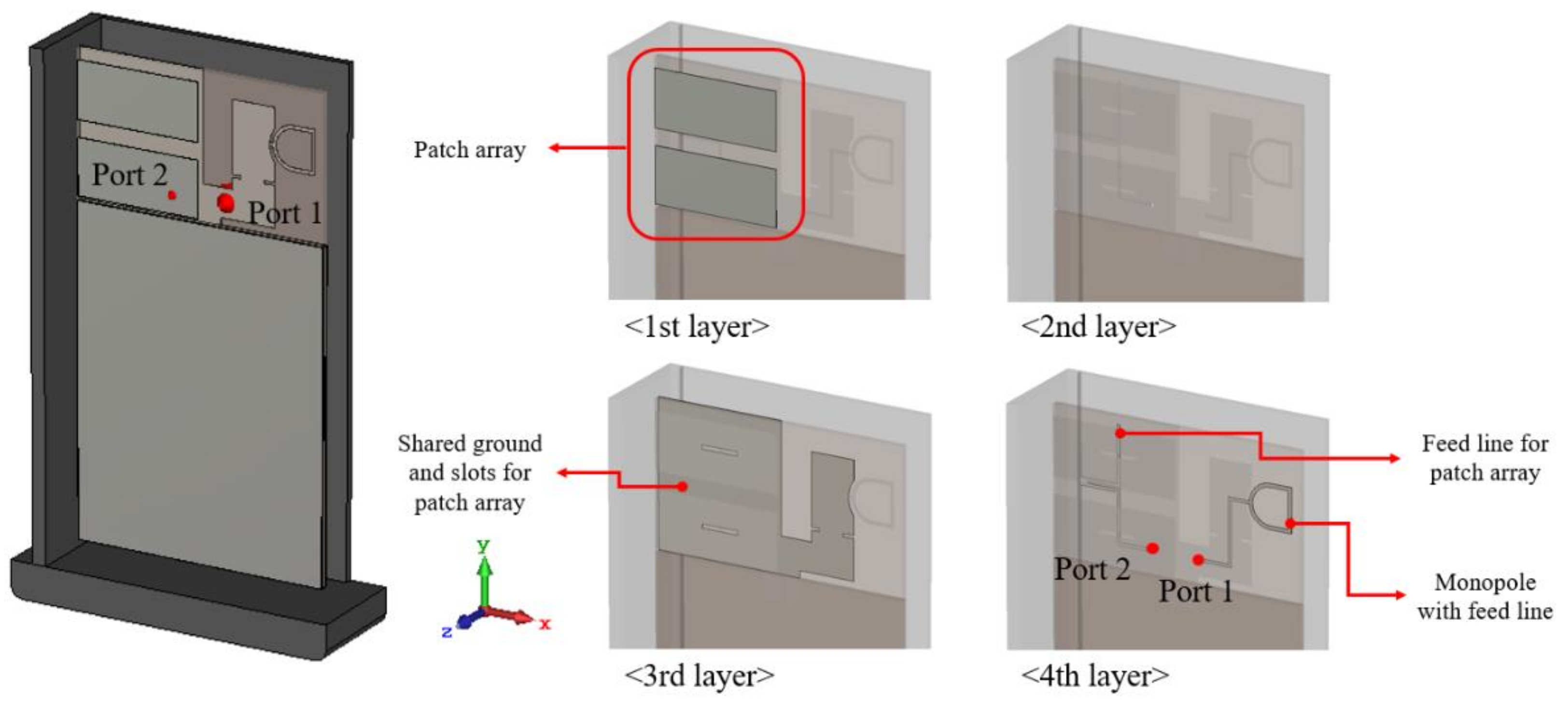
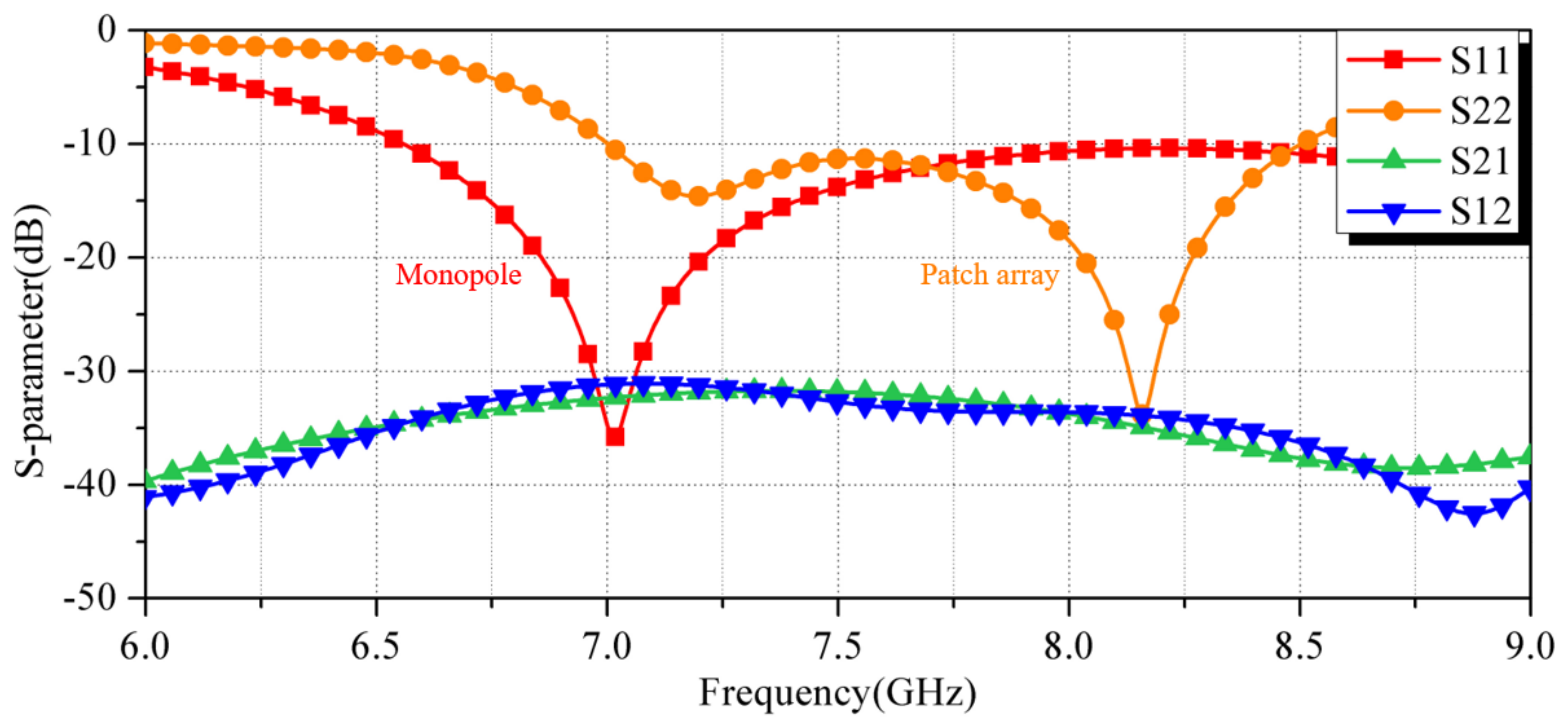

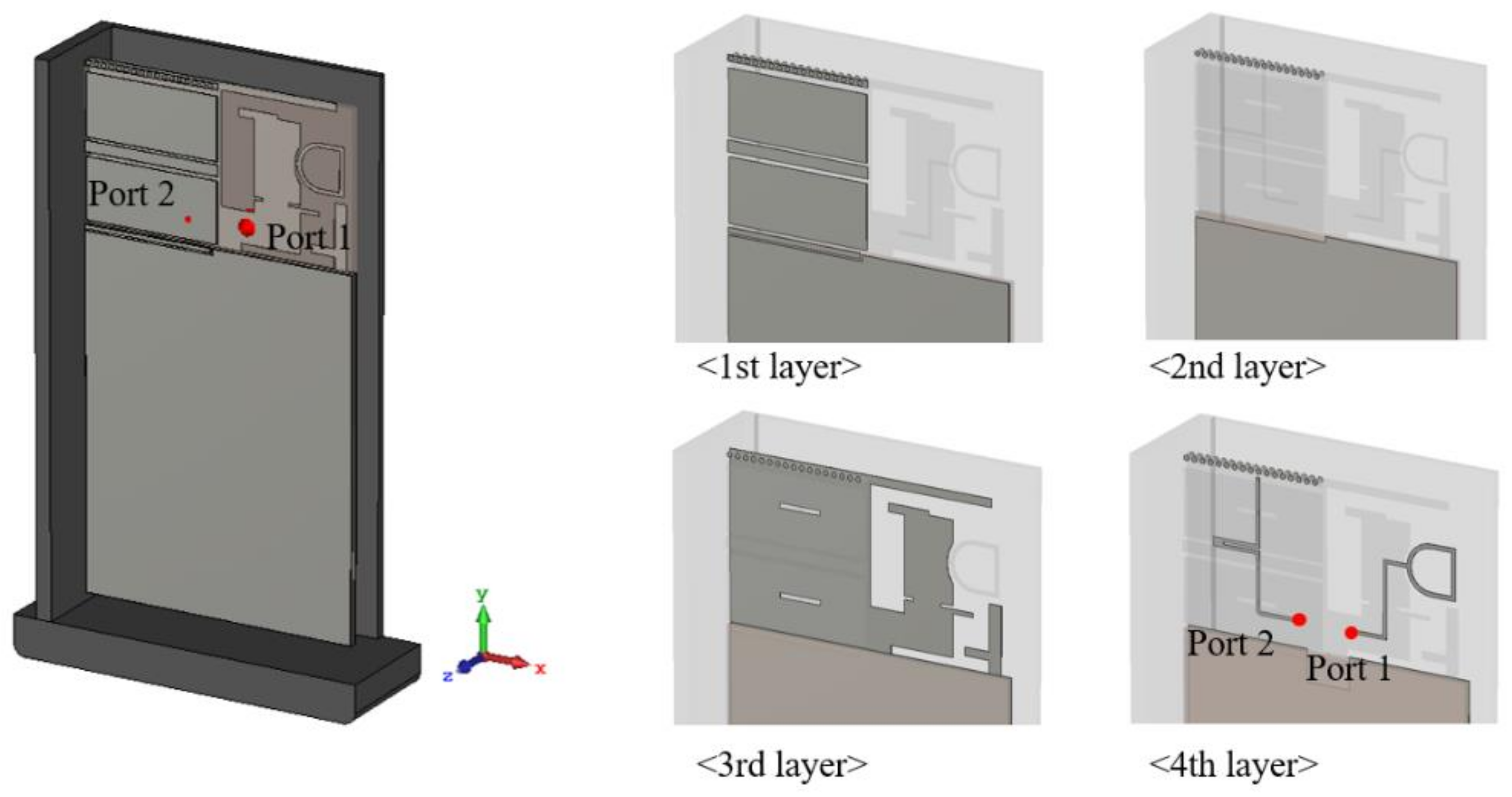
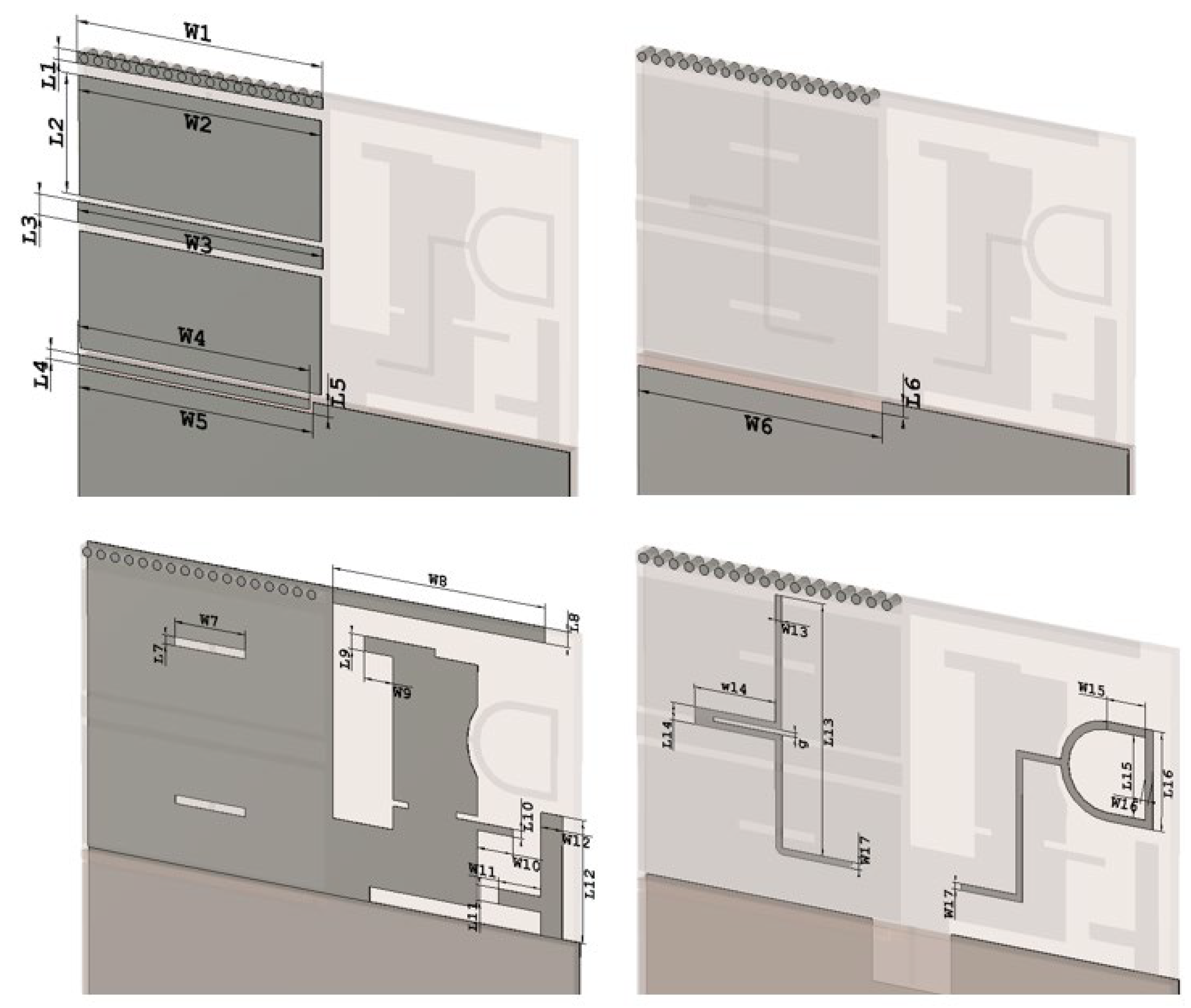
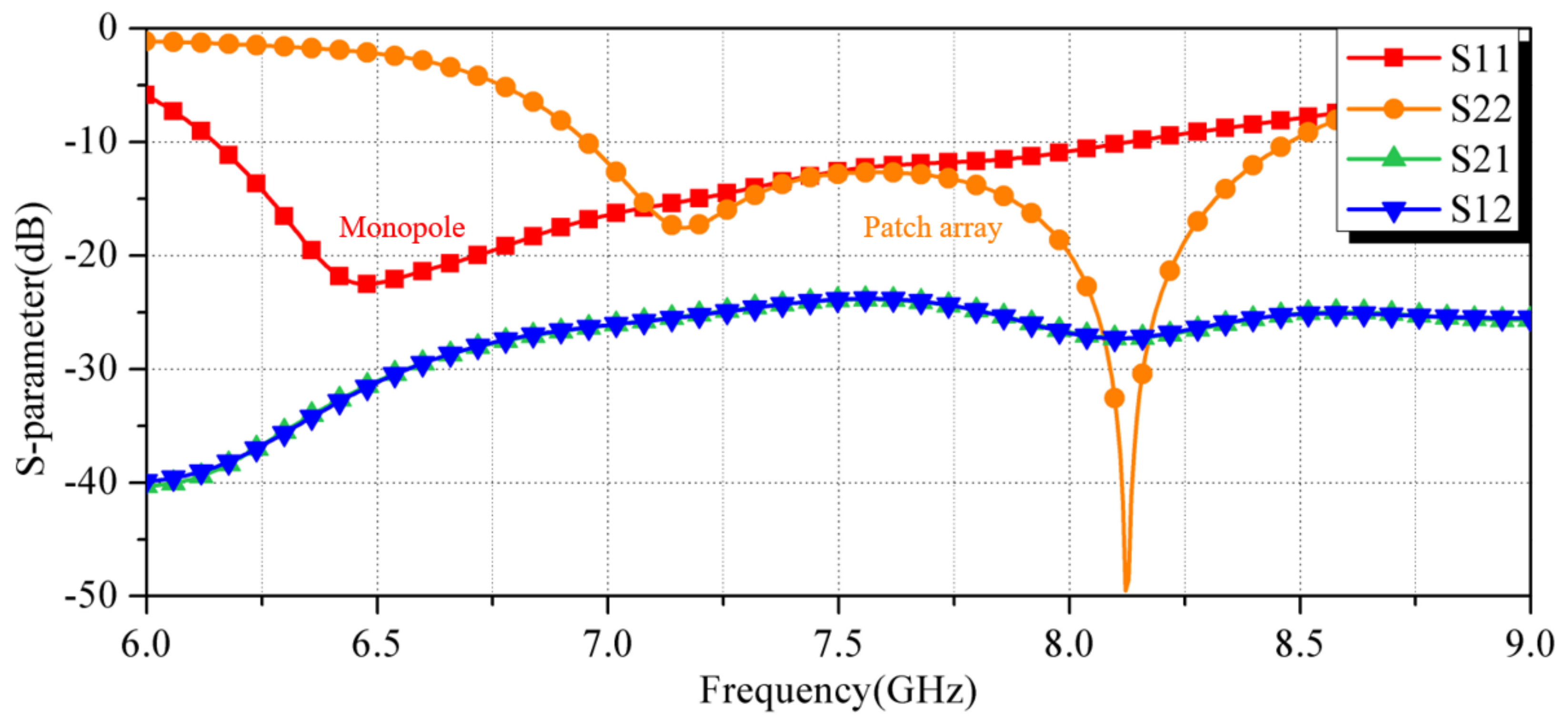



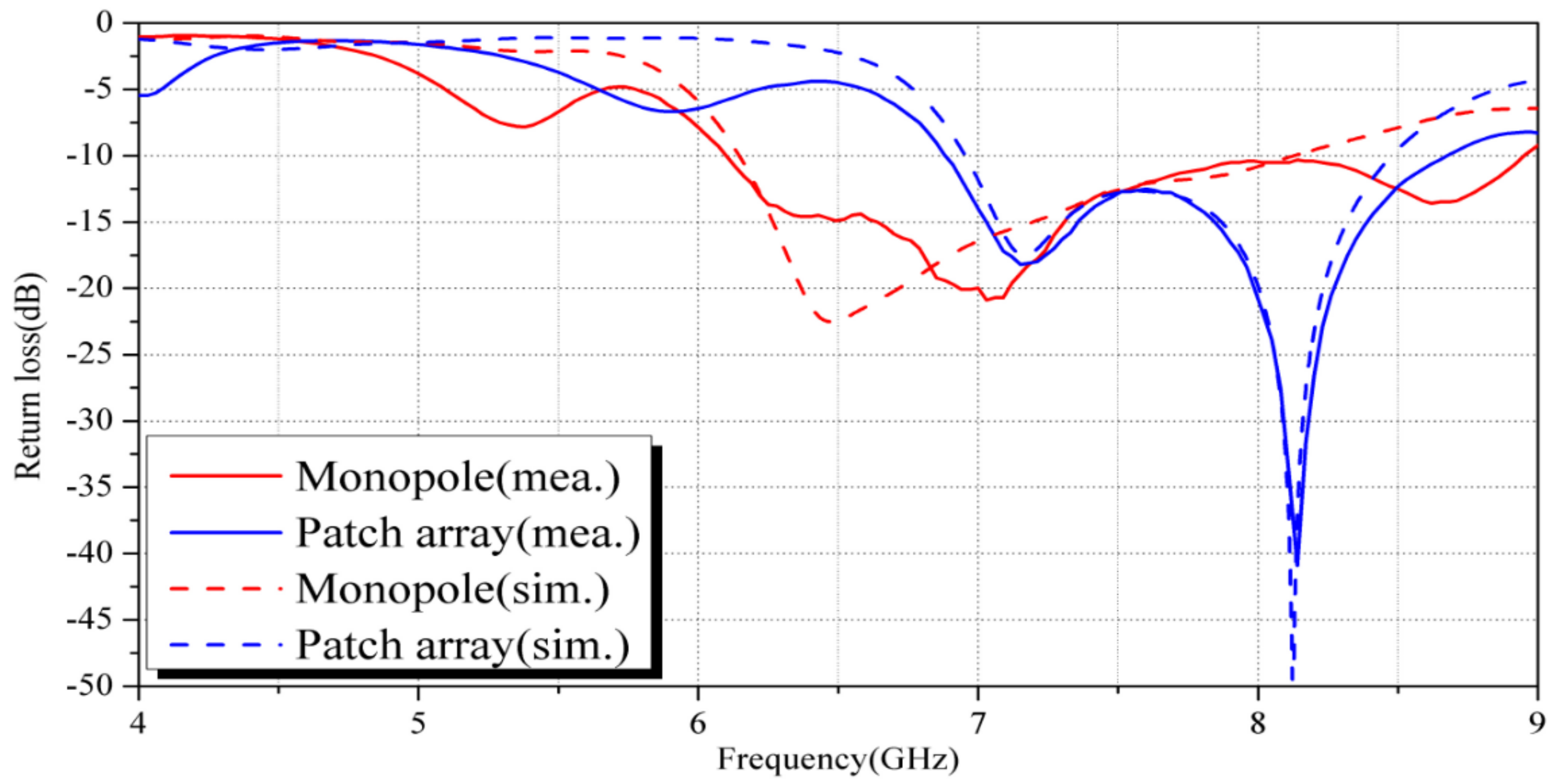



| Step 1 (Prototype) | Step 2 | Step 3 |
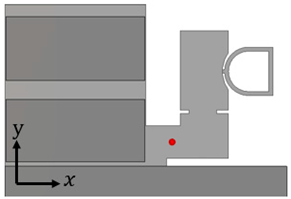 | 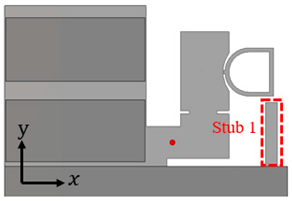 | 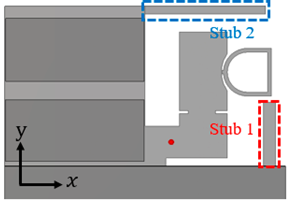 |
| Radiation Pattern of Monopole (yz-Plane) | ||
 | ||
| Radiation Pattern of Patch Array (xz-Plane) | ||
 | ||
| Step 3 | Step 4 | Step 5 |
 | ||
| Radiation Pattern of Monopole (yz-Plane) | ||
 | ||
| Radiation Pattern of Patch Array (xz-Plane) | ||
 | ||
| Step 5 | Step 6 | Step 7 |
 | ||
| Radiation Pattern of Monopole (yz-Plane) | ||
 | ||
| Radiation Pattern of Patch Array (xz-Plane) | ||
 | ||
| Parameters | Values | Parameters | Values |
|---|---|---|---|
| 17.5 mm | 0.75 mm | ||
| 17.25 mm | 7.88 mm | ||
| 17.5 mm | 1.37 mm | ||
| 16.55 mm | 0.65 mm | ||
| 16.8 mm | 0.74 mm | ||
| 17.5 mm | 0.74 mm | ||
| 0.74 mm | 0.57 mm | ||
| 15 mm | 1 mm | ||
| 2 mm | 1 mm | ||
| 2.5 mm | 0.5 mm | ||
| 3 mm | 1 mm | ||
| 1.5 mm | 8 mm | ||
| 0.4 mm | 15.3 mm | ||
| 5.35 mm | 1.07 mm | ||
| 2.5 mm | 5 mm | ||
| 0.5 mm | 6 mm | ||
| 0.4 mm | g | 0.4 mm |
| Monopole (6.5 GHz) | Monopole (8.0 GHz) | Patch Array (8.0 GHz) |
|---|---|---|
 | ||
| Monopole (6.5 GHz)—Front Part | |
| Left side | Right side |
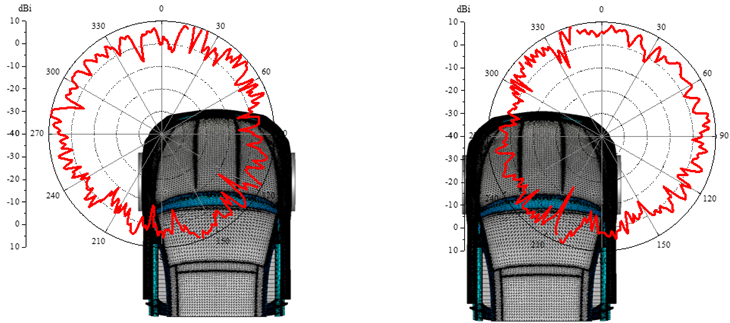 | |
| Monopole (6.5 GHz)—Rear Part | |
| Left side | Right side |
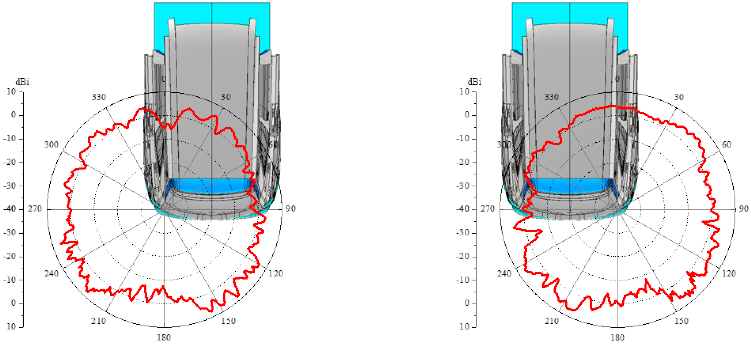 | |
| Monopole (8.0 GHz)—Front Part | |
| Left side | Right side |
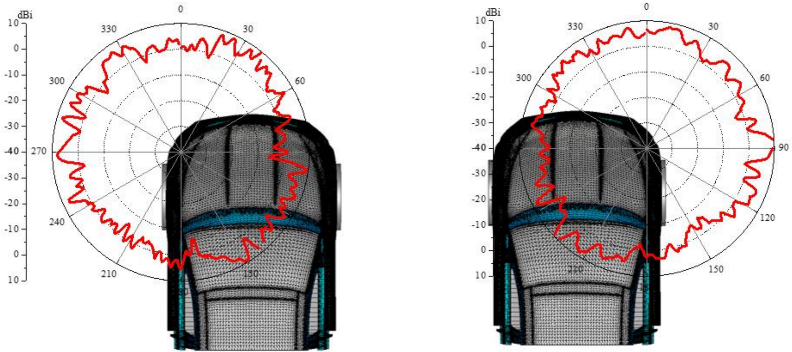 | |
| Monopole (8.0 GHz)—Rear Part | |
| Left side | Right side |
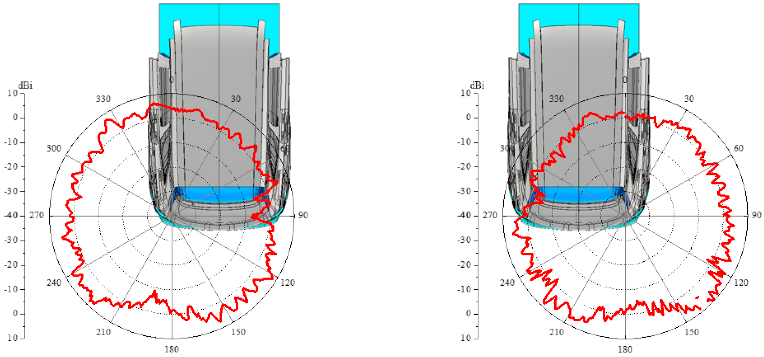 | |
| Patch Array (8.0 GHz) | |
| Left side | Right side |
 | |
| Ref. | Antenna Size | Bandwidth | Radiation Pattern | Number of Supporting Band | Complexity |
|---|---|---|---|---|---|
| [13] | 52 × 37 mm2 | 2.1~2.7 GHz /5.6~6.15 GHz | Omni only | 2 | Low |
| [14] | 66 × 52 mm2 | 0.698~2.7 GHz | Omni only | 3 | Low |
| [15] | 60 × 38.5 mm2 | 0.61~0.96 GHz /1.71~2.69 GHz /3.3~5 GHz | Omni only | 3 | Low |
| [16] | 50 × 25 mm2 | /0.698~0.96 GHz /1.71~2.69 GHz | Omni only | 2 | Low |
| [17] | 50 × 35 mm2 | 3.3~4.22 GHz | Directional only (3-state beam) | 1 | Medium |
| [18] | 30 × 30 mm2 | 3~12 GHz (mode 1) /2.42~2.7 GHz (mode 2) /3.47~4.05 GHz (mode 2 /5.73~5.84 GHz (mode 2) | Omni only (2-state beam) | 4 | High |
| This work | 37.5 × 20 mm2 | 6.14~8.24 GHz (mode 1) /6.95~8.47 GHz (mode 2) | Omni and directional (dual beam) | 3 | low |
Publisher’s Note: MDPI stays neutral with regard to jurisdictional claims in published maps and institutional affiliations. |
© 2022 by the authors. Licensee MDPI, Basel, Switzerland. This article is an open access article distributed under the terms and conditions of the Creative Commons Attribution (CC BY) license (https://creativecommons.org/licenses/by/4.0/).
Share and Cite
Cha, S.G.; Yoon, Y.J.; Lee, Y.J.; Hong, S.T.; Mun, H.S.; Park, Y.H. Integrated Module Antenna for Automotive UWB Application. Appl. Sci. 2022, 12, 11423. https://doi.org/10.3390/app122211423
Cha SG, Yoon YJ, Lee YJ, Hong ST, Mun HS, Park YH. Integrated Module Antenna for Automotive UWB Application. Applied Sciences. 2022; 12(22):11423. https://doi.org/10.3390/app122211423
Chicago/Turabian StyleCha, Seung Gook, Young Joong Yoon, Yoon Jin Lee, Seung Take Hong, Hyeon Sik Mun, and Yong Hee Park. 2022. "Integrated Module Antenna for Automotive UWB Application" Applied Sciences 12, no. 22: 11423. https://doi.org/10.3390/app122211423
APA StyleCha, S. G., Yoon, Y. J., Lee, Y. J., Hong, S. T., Mun, H. S., & Park, Y. H. (2022). Integrated Module Antenna for Automotive UWB Application. Applied Sciences, 12(22), 11423. https://doi.org/10.3390/app122211423





